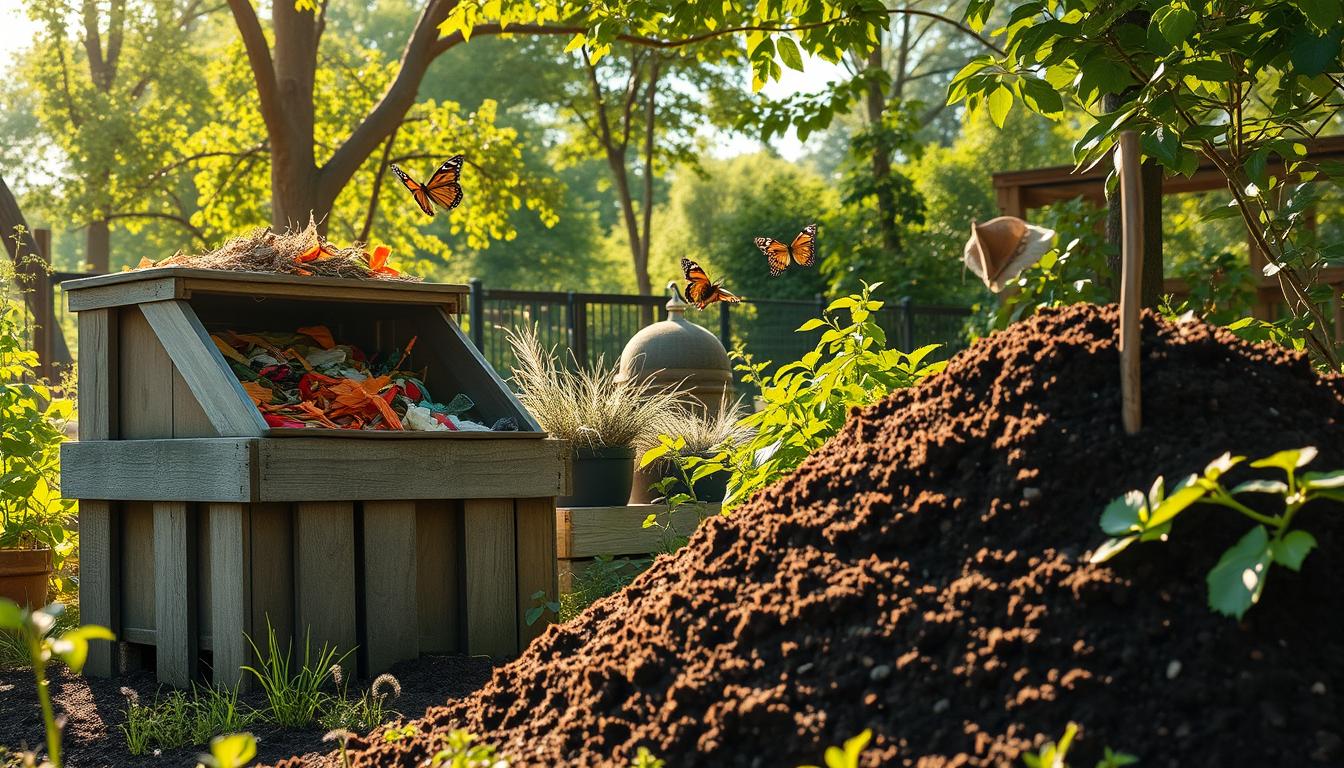I’m excited to share my composting journey with you. I hope it inspires you to start composting. I found it easy to begin, and it’s changed my garden for the better. This guide will teach you to reduce waste, make nutrient-rich soil, and support sustainable gardening.
Composting is great for the environment. It’s a simple way to help our planet. By using a few easy steps, you can start composting and enjoy its benefits.
In this article, I’ll share my experience and give you a detailed beginner’s guide. We’ll cover the basics, benefits, and common mistakes to avoid. This guide is perfect for starting or improving your composting routine. It’s a great resource for anyone looking to get started with composting.
Why I Started Composting
I started composting to help the planet and make my garden better. It lets me turn waste into something useful. This way, I can help reduce harmful gases and methane.
Composting makes my garden soil better, making plants grow stronger. To start, just collect kitchen scraps and yard waste. Use the right bin and follow simple steps. This way, you can make your garden flourish and help the environment.
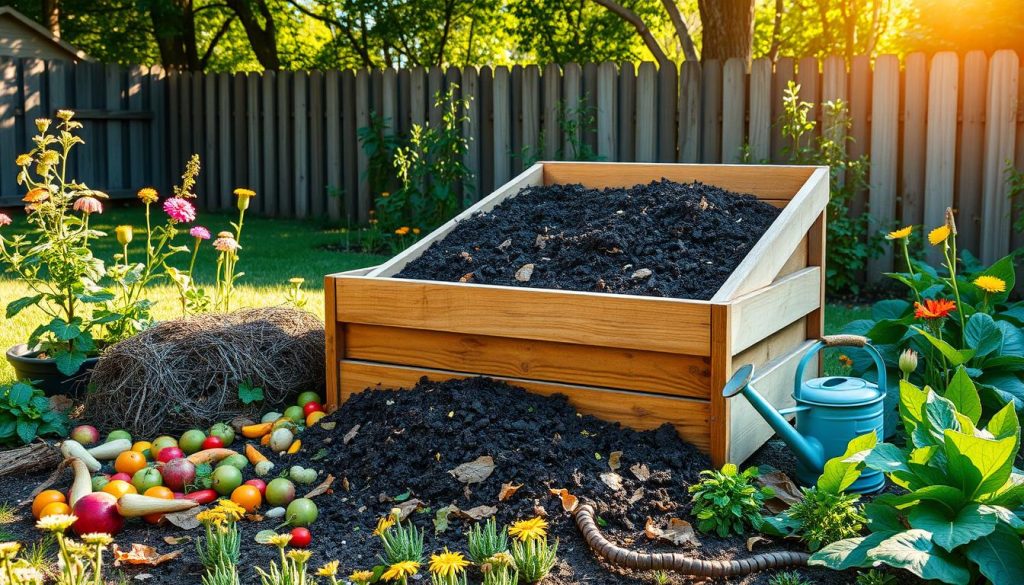
- Reduced waste sent to landfills
- Lower greenhouse gas emissions
- Improved soil health and fertility
- Increased plant growth and productivity
Composting has made my garden more sustainable. It gives me fresh, healthy food. If you garden, or want to, try composting. It’s good for the planet and your garden.
Getting Started with Composting
Starting with composting basics is key. It might seem tough for beginners, but with the right tips, you’ll soon have a great compost pile. First, pick the right compost bin and set up a spot for it.
When picking a compost bin, think about size, material, and air flow. Good air flow is key for a healthy pile. Also, choose something easy to put together, clean, and keep up. Options include plastic bins, wooden pallets, and wire mesh.
Choosing the Right Compost Bin
- Size: Think about how much space you have and how much waste you make.
- Material: Pick something tough and easy to clean that can handle the weather.
- Ventilation: Make sure the bin lets in enough air for a healthy pile.
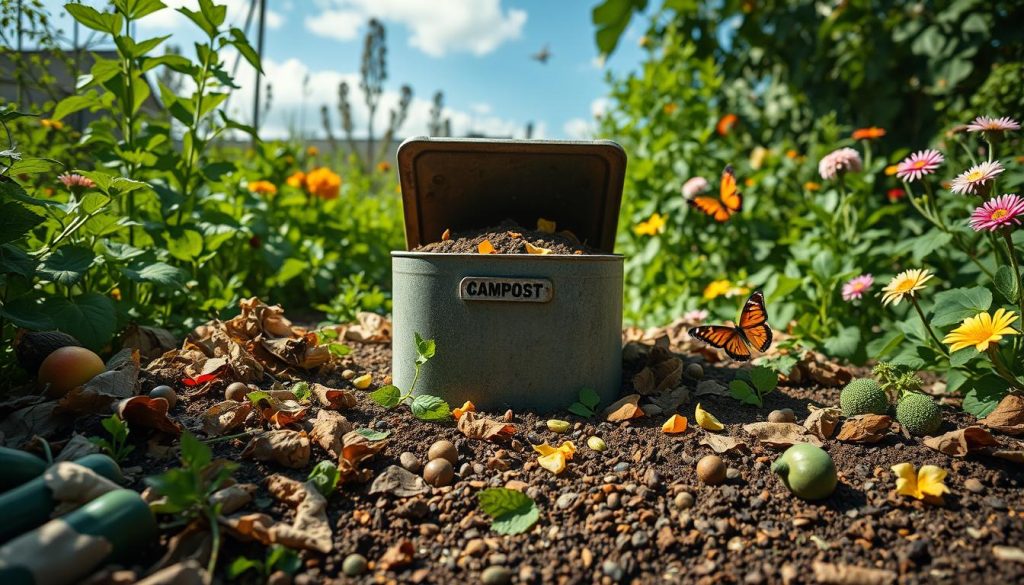
Setting Up My Compost Area
After picking your bin, set up your compost area. Find a spot that’s well-ventilated and easy to get to. Start small and grow your pile as you get better at composting.
| Compost Bin Size | Recommended Space |
|---|---|
| Small (1-2 cubic feet) | 2×2 feet |
| Medium (3-4 cubic feet) | 3×3 feet |
| Large (5-6 cubic feet) | 4×4 feet |
By following these tips and picking the right bin, you’ll be on your way to a great compost pile. Keep your area clean, well-ventilated, and easy to get to for the best composting results.
What Can I Compost?
Knowing what to add to your compost pile is key. As a beginner, I started with simple tips. I learned to mix kitchen scraps and yard waste. This balance of “green” and “brown” materials is crucial.
To begin composting, I added a mix of materials to my pile. Here are some kitchen scraps I use:
Kitchen Scraps I Use
- Fruit and vegetable peels
- Tea bags
- Coffee grounds
I also add yard waste to my compost. Some must-haves include:
Yard Waste Essentials
- Leaves
- Grass clippings
- Branches
Following these tips, I’ve made a rich compost for my garden. It’s important to balance your materials and keep your pile healthy. This way, you’ll get the best from your composting.
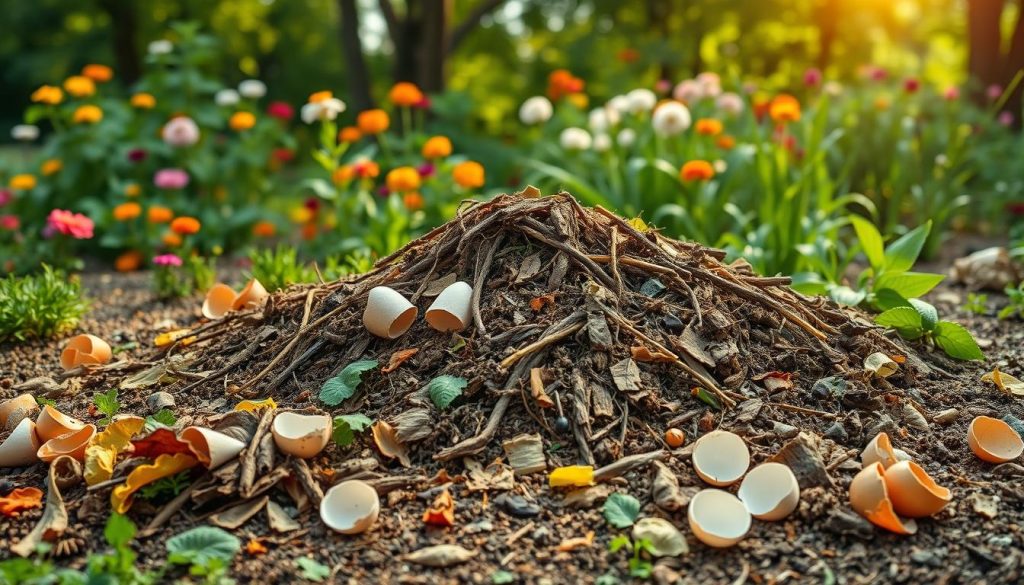
What Not to Compost
Starting with composting? It’s key to know what not to add to keep your pile healthy. A beginner’s guide can steer you clear of mistakes. Meat, dairy, and pet waste are off-limits because they attract pests and smell bad.
Composting can be tricky for beginners, but with the right tips, you can keep your pile pest-free and odorless. Don’t compost plastic, metal, or glass as they can harm plants and contaminate the compost. By avoiding these items, you’ll make a compost that’s good for your garden.
Common Mistakes to Avoid
- Adding meat, dairy, and pet waste to the compost pile
- Including plastic, metal, and glass in the compost
- Not balancing green and brown materials in the compost pile
Why Some Items Should Be Avoided
Using a beginner’s guide and following simple tips can help you avoid mistakes. By not adding certain items and balancing your compost, you’ll get a nutrient-rich mix. This is great for your garden.
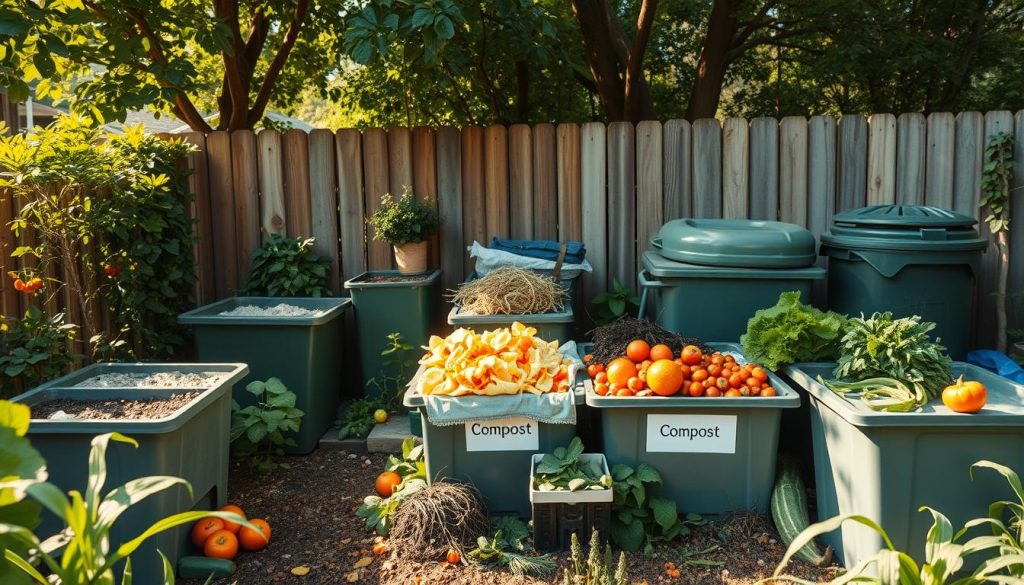
The Science Behind Composting
Starting with composting 101 for beginners means learning about how organic materials break down. Microorganisms like bacteria and fungi do this work. They turn materials into nutrient-rich compost by releasing heat and carbon dioxide.
When you start composting, knowing about microorganisms is key. They are the heart of the decomposition process.
A good beginner composting guide will talk about temperature. It’s important to keep an eye on your compost pile’s temperature. This ensures microorganisms work well, breaking down materials efficiently.
The best temperature for composting is between 130°F and 140°F. This range helps microorganisms thrive, making composting effective.
Understanding Microorganisms
Microorganisms are vital in composting. Their work depends on oxygen, moisture, and temperature. By supporting their growth, you speed up decomposition and get better compost.
The Role of Temperature
Temperature is crucial in composting. It impacts how microorganisms work. Here’s a table showing the best temperature ranges for composting:
| Temperature Range | Microorganism Activity |
|---|---|
| 50°F – 100°F | Slow decomposition |
| 100°F – 130°F | Moderate decomposition |
| 130°F – 140°F | Optimal decomposition |
| 140°F – 160°F | Rapid decomposition |
Maintaining My Compost Pile
To keep my compost pile healthy, I follow some easy tips. One key step is turning the pile regularly. This ensures it gets enough air and speeds up decomposition. These tips help me make nutrient-rich compost for my garden.
When starting to compost, keeping the right moisture is key. The pile should be as damp as a sponge. This helps microbes grow and keeps pests away. Here are some tips for a healthy compost pile:
- Turn the pile every 7-10 days
- Monitor moisture levels regularly
- Add a mix of “green” and “brown” materials to the pile
By following these tips, I create a compost pile that’s full of nutrients. Remember to keep it moist and turn it often for the best results.
Turning the Pile
Turning the compost pile is crucial. It adds air, speeding up decomposition and preventing pests.
Monitoring Moisture Levels
It’s important to check the pile’s moisture. It should be as damp as a sponge. This helps microbes and prevents pests.
| Composting Tips | Benefits |
|---|---|
| Turn the pile every 7-10 days | Ensures adequate aeration and speeds up decomposition |
| Monitor moisture levels regularly | Helps microorganisms thrive and prevents pest growth |
| Add a mix of “green” and “brown” materials | Creates a balanced compost pile with optimal carbon-to-nitrogen ratio |
Troubleshooting Common Issues
As a beginner’s guide to composting, we need to tackle common problems. Simple tips can help you solve these issues and keep your compost healthy. Composting can be tough for newbies, but with the right methods, you can fix common problems and succeed.
Odor Problems and Solutions
Odor issues are a big problem in composting. Here are some solutions:
- Adding more “brown” materials, like dried leaves or straw, to balance out “green” materials
- Turning the pile regularly to ensure good air flow
- Making sure the compost pile isn’t too wet or too dry
Attracting Pests and Preventing Them
To keep pests away, like rodents or flies, try these tips:
- Don’t add meat or dairy to your compost
- Use a physical barrier, like a tarp or lid, to cover the pile
- Try natural pest repellents, like citrus peels or cinnamon
By using these simple tips and solving common problems, you can keep your compost pile healthy and pest-free. This way, you can enjoy composting’s benefits for your garden.
| Common Issue | Solution |
|---|---|
| Odor problems | Add more “brown” materials, turn the pile regularly, and ensure adequate aeration |
| Pest infestations | Exclude meat and dairy, cover the pile, and use natural pest deterrents |
Composting Methods I’ve Tried
I’ve tried many composting methods, including hot and cold composting. For beginners, it’s helpful to look at easy composting tips. This helps find what fits your lifestyle and space.
Starting to compost is simple. You just need to pick the right materials, keep the right moisture, and ensure good air flow. These steps help anyone start composting and enjoy the benefits of reducing waste and making nutrient-rich soil.
Hot and cold composting differ in maintenance and speed. Hot composting makes a pile hot, killing off bad stuff. Cold composting is slower, adding materials to break down over time. Trying different methods helps find what works best for you and rewards your efforts.
Hot Composting Techniques
- Requires regular turning and maintenance
- Breaks down materials quickly, often in a matter of weeks
- Kills off pathogens and weed seeds, creating a sterile compost
Cold Composting for Beginners
- Requires less maintenance and attention
- Breaks down materials slowly, often over several months
- Creates a rich, diverse compost teeming with microorganisms
How to Know When Compost is Ready
Starting with composting can seem tough, but it’s easier with a guide. Knowing when your compost is ready is key. It’s a crucial step in using it in your garden.
Look for an earthy smell, dark brown color, and crumbly texture. Squeeze a handful of compost. If it holds shape but crumbles, it’s ready. Here are the main signs:
- Earthly aroma: A rich, earthy smell means your compost is ready.
- Dark brown color: Ready compost is usually dark brown.
- Crumbly texture: It should feel like soil when crumbled.
By using these tests, you’ll know when your compost is ready. This lets you enjoy composting’s benefits. Always follow a beginner’s guide to start composting right.
Testing for Readiness
Testing your compost is vital. These simple tests help ensure your compost is ready. They’re important for both new and experienced composters.
Using My Compost
I’m thrilled to use my compost in my garden. Adding compost to the soil makes my garden thrive. It’s easy to do with the right tips.
Incorporating Compost into My Garden
I’ll mix compost into the soil as a natural fertilizer. Here are some tips for beginners:
- Start by mixing a 2-inch layer of compost into the top 6 inches of soil
- Use compost to create a nutrient-rich potting mix for containers
- Make a compost tea to use as a liquid fertilizer
Sharing with Friends and Neighbors
I’m excited to share my compost with friends and neighbors. It’s a great way to spread the word about composting. If you want to start composting, check out online resources for beginner advice.
| Composting Method | Benefits |
|---|---|
| Hot Composting | Fast decomposition, kills weed seeds |
| Cold Composting | Easy to set up, low maintenance |
Staying Motivated While Composting
Composting can be rewarding but it takes effort. Setting up a regularcomposting schedule helps a lot. It keeps the process moving forward.
By dedicating a specific time each week, my compost pile gets the care it needs. This makes sure it stays healthy.
Celebrating my composting successes keeps me going. It doesn’t matter how small they are. Sharing my compost with friends or seeing how much waste I’ve saved is rewarding.
Composting is a journey, and staying committed is key. I’ve created a thriving garden that brings me joy. With planning and a positive mindset, you can enjoy composting too.

